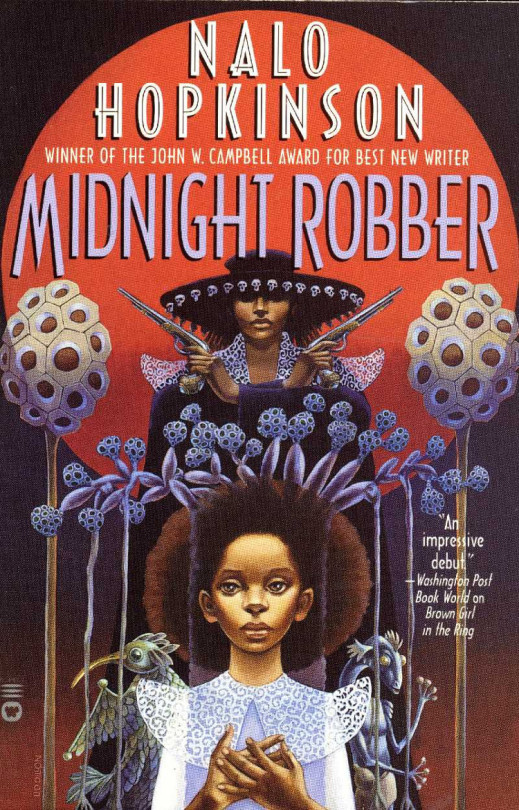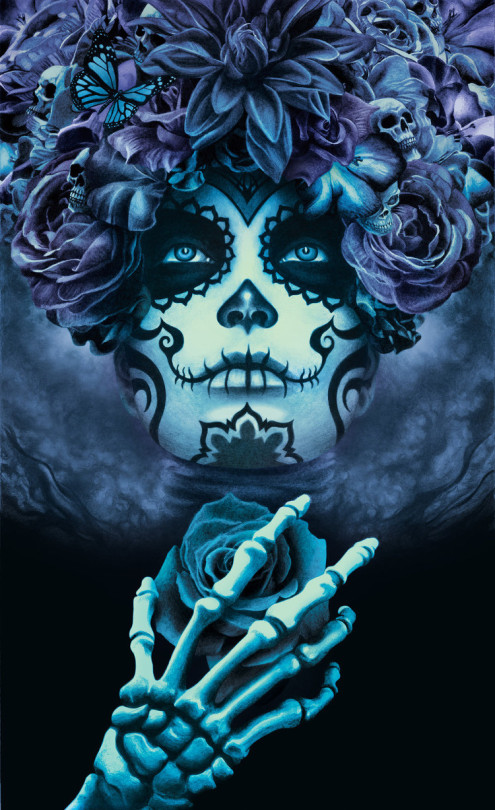Tachyon tidbits featuring Nalo Hopkinson, Tim Powers, Brandon Sanderson, and John Picacio
The latest reviews and mentions of Tachyon titles and authors from around the web.

Nalo Hopkinson (photo: David Findlay), Tim Powers (Matt Gush), Brandon Sanderson ((Ceridwen via Wikimedia Commons) , and John Picacio
At B&N SCI-FI & FANTASY BLOG, Ceridwen Christensen includes Nalo Hopkinson in 13 Essential #Ownvoices Science Fiction & Fantasy Novels.
The #ownvoices hashtagseeks to remedy this experience gap, pointing out fictions about and from the identities in question. They are, in other words, stories from inside looking out. Heretofore, this hashtag has been largely used to classify young adult fiction. While I can see the pedagogical reasons for this, maybe us olds would be well served by identifying #ownvoices in narratives written for us as well. Science fiction often deals with the alien—the discovery and slow understanding of other cultures, civilizations, and peoples. As such, science fictional or fantastic fiction can be a rich canvas on which to explore the differences that already mark us, stretching our understandings and misunderstandings that much farther. For people who have been marked as other within their own lives, this fictional extremity can be the sort of alienating canvass that resonates.
To that end, here are 13 works that tell stories from the intimacy of cultural identity and the extremity of the SFFnal.

The backstory for Jamaican-born Naolo Hopkinson’s beautifully textured Midnight Robber is almost too complex to sum: a young girl, Tan-Tan, is taken by her disgraced mayor father from the Caribbean-colonized world of Toussaint to the planet’s strange, alternate-universe twin, peopled largely by criminals from Toussaint (like her father). Tan-Tan matriculates under her dad’s rough care in a place where reality is stretchy. There, creatures of Caribbean myth are real, and Tan-Tan grows into a person of lore herself—the Midnight Robber, a sort of Robin Hood who spouts the poetry of the Carib. The language of the novel is a complex patois, something you must lower yourself into slowly, even while it roils. It is a heady mix of the SFFnal and the folkloric.
Jeff Somers, also at B&N SCI-FI & FANTASY BLOG, mentions Tim Powers in 10 of the Scariest Haunted House Books Ever.
There’s something primal about a haunted house story—stories in which a structure that’s supposed to shelter you turns against you. It’s a trope that we keep returning to—this week, Netflix launched a new series based on the classic Shirley Jackson novel The Haunting of Hill House, and the results are truly terrifying (if at a bit of a remove from the book).

Medusa’s Web, by Tim Powers
When their aunt dies, orphans Scott and Madeline return to Caveat, the rotting house they were raised in. Their cousins Ariel and Claimayne still live in the old Hollywood Hills mansion, and still guard the family’s secret—that they are part of a network of old Los Angeles families that use magical, rune-like drawings known as Spiders to travel freely between 1920s Hollywood and the present day, switching bodies with people in the earlier era. Part sci-fi, part the photo at the end of Kubrick’s The Shining, the story explores addiction in ways no one else has ever tried, revving up a horrifying tale of seduction as Madeline slowly falls under the spell of Caveat and the strange, intense pleasures that the Spiders offer, even as Scott becomes increasingly desperate to get them away.
For TOR.COM, Weston Ochse list Five Books About Heroes Who Shouldn’t Babysit Your Kitten includes mentions of Brandon Sanderson’s Kaladin.
Who doesn’t like kittens? Kittens are what cats used to be before the irony of a two-legged universe got to them, making them the moody judgmental purring balls of fur they are today. Kittens are fun. Kittens are daring. Kittens are little evil feline ninjas with razor teeth and spikey claws. Kittens wake up every morning and treat the world like it’s their own personal frat house and the air is spiked with catnip. I love kittens. I also love me righteous protagonists in books and comics. So, I was wondering the other day—I’d trust these folks to save the world, but would I trust them to babysit a kitten?

Who can I trust, then? Having just read Brandon Sanderson’s book The Way of Kings about shards and monsters and bright eyes, his hero Kaladin came to mind. He was a decent warrior and a pretty solid bloke. Except of course for his deep emotional scars and his desire to protect and serve a Tinkerbell-like creature—an Honorspren named Syl. That’s sort of like a kitten, I suppose, except it flies through the air and does some magical stuff, which means it’s really nothing like a kitten. In fact, I could see that damned Spren becoming Butt-Hurt-Spren because of Kaladin’s attention on a new kitten. After all, it’s Syl’s connection to Kaladin that grounds her and makes her able to think clearly, unlike her Windspren cousins, which would definitely make the kitten a threat. One moment Kaladin is petting the kitten, listening to it purr as it rests on a cushion beside him, the next the kitten is being carried to ten thousand feet by the spren who then returns it by dropping it from an impossible height

Mia Araujo interviews John Picacio as part their Artists of Color series.
3). When did you first fall in love with art, and realize that you wanted to pursue it as a career? Did your parents approve or disapprove?
I can’t remember not loving it. Comic books are amongst my earliest memories, dating back to first grade. When I was a kid, I don’t think I let my mother take a grocery trip without me buying a comic off the spinner rack. Back then, my friend Eddie Moody had this tattered hardcover book called The Great Comic Book Heroes by Jules Feiffer. It featured the original first-issue origin stories of Superman, Batman, The Human Torch, The Flash, The Spectre, Captain America, and so on. I couldn’t get enough of that book. Comics led to Star Trek, led to Star Wars, led to more sf/f films and magazines. I’ve always loved anything related to science fiction and fantasy.
Fast forward to college – I did a semester in Europe during my third year of architecture school. The first stop of the trip was in London, and one day, I played hooky from the rest of the group and went to Gosh! Comics – back when it used to be across from the British Museum. The shop owner saw me looking at a poster rack containing original comics art. I stopped cold when I saw a page of original Dave McKean art from Arkham Asylum. There were several more in there, and he took out the pages and let me spread them out on the floor. I just stared at them for a very long time. There was ink, graphite, acrylic and layers of collage everywhere. It was a revelation. At the time I had been discovering graphic novels like Violent Cases and Watchmen – and the more I kept visiting museums across Europe, the more I knew architecture was not enough for me.
I got my degree and started working as an intern architect out of school, but by night, I wrote, drew, and self-published my own comics stories. Those comics led a publisher called Mojo Press to ask if I would be interested in doing cover art for a Michael Moorcock book. Doing that job was the hook that changed my life. I fell in love with the business and with the process of being a cover illustrator, and my days in the architecture biz were officially numbered. I started living, eating, breathing the business of illustration and kept working to score art jobs, building my portfolio in my off-hours. Five years later, I went full-time as a science fiction / fantasy cover illustrator and I’ve never looked back.
